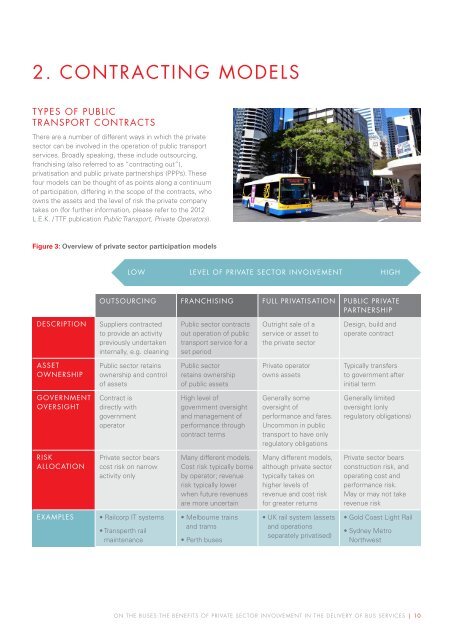ON THE BUSES
TTF-On-The-Buses-Report-2016
TTF-On-The-Buses-Report-2016
You also want an ePaper? Increase the reach of your titles
YUMPU automatically turns print PDFs into web optimized ePapers that Google loves.
2. C<strong>ON</strong>TRACTING MODELS<br />
TYPES OF PUBLIC<br />
TRANSPORT C<strong>ON</strong>TRACTS<br />
There are a number of different ways in which the private<br />
sector can be involved in the operation of public transport<br />
services. Broadly speaking, these include outsourcing,<br />
franchising (also referred to as “contracting out”),<br />
privatisation and public private partnerships (PPPs). These<br />
four models can be thought of as points along a continuum<br />
of participation, differing in the scope of the contracts, who<br />
owns the assets and the level of risk the private company<br />
takes on (for further information, please refer to the 2012<br />
L.E.K. / TTF publication Public Transport, Private Operators).<br />
Figure 3: Overview of private sector participation models<br />
LOW<br />
LEVEL OF PRIVATE SECTOR INVOLVEMENT<br />
HIGH<br />
OUTSOURCING FRANCHISING FULL PRIVATISATI<strong>ON</strong> PUBLIC PRIVATE<br />
PARTNERSHIP<br />
DESCRIPTI<strong>ON</strong><br />
Suppliers contracted<br />
to provide an activity<br />
previously undertaken<br />
internally, e.g. cleaning<br />
Public sector contracts<br />
out operation of public<br />
transport service for a<br />
set period<br />
Outright sale of a<br />
service or asset to<br />
the private sector<br />
Design, build and<br />
operate contract<br />
ASSET<br />
OWNERSHIP<br />
Public sector retains<br />
ownership and control<br />
of assets<br />
Public sector<br />
retains ownership<br />
of public assets<br />
Private operator<br />
owns assets<br />
Typically transfers<br />
to government after<br />
initial term<br />
GOVERNMENT<br />
OVERSIGHT<br />
Contract is<br />
directly with<br />
government<br />
operator<br />
High level of<br />
government oversight<br />
and management of<br />
performance through<br />
contract terms<br />
Generally some<br />
oversight of<br />
performance and fares.<br />
Uncommon in public<br />
transport to have only<br />
regulatory obligations<br />
Generally limited<br />
oversight (only<br />
regulatory obligations)<br />
RISK<br />
ALLOCATI<strong>ON</strong><br />
Private sector bears<br />
cost risk on narrow<br />
activity only<br />
Many different models.<br />
Cost risk typically borne<br />
by operator; revenue<br />
risk typically lower<br />
when future revenues<br />
are more uncertain<br />
Many different models,<br />
although private sector<br />
typically takes on<br />
higher levels of<br />
revenue and cost risk<br />
for greater returns<br />
Private sector bears<br />
construction risk, and<br />
operating cost and<br />
performance risk.<br />
May or may not take<br />
revenue risk<br />
EXAMPLES<br />
• Railcorp IT systems<br />
• Transperth rail<br />
maintenance<br />
• Melbourne trains<br />
and trams<br />
• Perth buses<br />
• UK rail system (assets<br />
and operations<br />
separately privatised)<br />
• Gold Coast Light Rail<br />
• Sydney Metro<br />
Northwest<br />
<strong>ON</strong> <strong>THE</strong> <strong>BUSES</strong>:<strong>THE</strong> BENEFITS OF PRIVATE SECTOR INVOLVEMENT IN <strong>THE</strong> DELIVERY OF BUS SERVICES | 10


